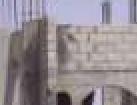
September 5, 2001
I was surfing the Reuters photo archive recently and came upon
two images that seemed to be teasing rather than informing. What did it
was the combination of 1) the sky -- lavender instead of azure and not
grading toward pale at the horizon, 2) the tower-like structure
in the center -- looking like a cross between a video game and an
Escher drawing, and 3) the collage-like jumble surrounding the "tower".
I wondered whether these pictures might have been created with computer
graphics software, at least in part.
This is not a forbidden thought for me, inasmuch as my model of the news
industry is based on two facts: 1) there is no law that says anything
in the news media has to
be true and 2) I'm probably not the
first person in history to have considered the implications of (1).

| The caption is about the building in the background, right?... |

| ...until our photographer -- real or virtual -- steps backward into the remains of another building...oh...so THAT was the house... |
First: provenance. The Reuters archives pages where I found the original pictures are: First and Second .
Now, the fun part. And it's especially fun to analyze news photos on those rare occasions when you find two or more of the same scene taken at different times. Then if there's something odd in the scene, you might have some additional data points to use in figuring out how it got that way.
The scene here was shot twice from almost the same point in the left-right direction. We can see this from the position of the rearmost bundle of rebar sticking up from the top of the building: (In all the examples to follow, the lefthand member of the pair is from the first picture, the righthand member is from the second picture.)

|

|
The second picture was taken from a point slightly to the left of the first picture. In the forward-backward direction, the viewer is closer to the tank in the first picture, because the tank is larger relative to the building in that one.
So much for the where of the images. What about the when? The building has been partially demolished on either side, and in the second picture a large amount of material on the right side has disappeared. So we must assume that, if this is a real-world scene, the second picture is also the later of the two. But how much later? The shadow on the building gives us a clue:

|

|
The change in the position of the shadow falling on the narrow arched opening is obvious, so the time elapsed between the two images must have been at least several minutes. If we knew the compass orientation of the building, we could actually compute the number of minutes elapsed, because we could derive the sun angles from the angles of the shadows. Failing this, though, we can say only that there must have been enough time for that mass of material to have been removed -- and for any dust clouds to dissipate.
Looking at the building itself, we see that there are columns with rebar sticking out, which announces that this is a modern reinforced concrete structure. The purpose of the building is not clear, but the remaining intact part of it suggests an identical floor plan for each of its two stories. The rebar sticking up from the top of the central structure suggests that another floor was planned.
But where are the columns that should support the building on the side facing us? The visible columns are exclusively at the far side of the structure except for one on the left that seems to go through the center of a floor section. This also is improbable. And if this building is made of reinforced concrete, why were the floors not reinforced also? One expects to see an integrated structure that wouldn't fold, as this building seems to have done, but would instead sag or buckle in response to force, like this old school building in my neighborhood that's being demolished:

|
In particular, the floor -- if that's what it is -- that has snapped...

|

|
If this building was under construction, where is the material for forms? There should be a lot of lumber visible, which would have been necessary to support the uppermost floor while it was being poured.
All in all, while this building may not be physically impossible, it is certainly improbable. But to return to light and shadow: the sky also is improbable. In the first image in particular, the sky doesn't grade toward pale toward the horizon:

|
Finally, there is a blemish in the second image that defies explanation:

|

|
In conclusion, I think the most parsimonious explanation for all the oddities in these images is that the building existed only in the mind of the computer graphics whiz who concocted it. We know that hoaxes have already been perpetrated by individuals who have inserted material into the online news stream. Recall the former employee of the business news service who was able to plant a fake story about a company after he had taken a position in its stock from which he would benefit when the "news" broke. In the case considered here, if the hoax was perpetrated by an individual acting alone, the satisfaction would presumably have been intellectual rather than financial. As for the possibility that the hoax might instead be a part of some larger program to introduce ambiguity or just plain noise into the news stream, discussion of that is beyond the scope of this article.